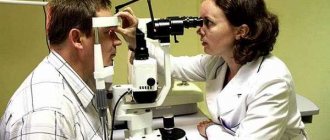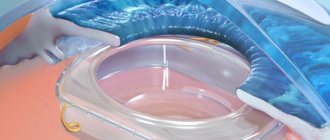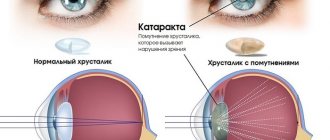What is known about the unconventional method
The name of the diagnostic method is associated with the pantheon of ancient Greek gods, where Iris was the goddess of the dawn. The multi-colored tints of its train covered the sky with all the colors of the rainbow; the Greeks used the word “iris” to designate the iris of a person’s eye. By analogy with the Greeks, the term “iris” appeared in modern medicine.
The human eye is a unique but complex organ. The pattern of the iris (iris) is as unique as a fingerprint. It is believed that most diseases leave marks on the iris, and changes in the pattern can make a correct diagnosis.
Healers claim that the iris is like a screen that visualizes the state of all human systems and organs. Anomalous processes change the pattern under the influence of redistribution of pigments; various images of projection zones are collected by supporters of the method in the Atlas of Special Maps.
Historical chronology
In modern medical centers, diagnostics are advertised as a progressive way to detect the disease at its earliest stage. But iridology, in some sources called iridology, has been known for a long time.
- Tibetan healers of the distant past were involved in examining the iris, which is reflected in handwritten texts dating from the 5th to 8th centuries. There are also later historical references to the ancient healers of India and physicians of China practicing the technique.
- The right of primacy in popularizing iridology belongs to the Egyptian priest El Aksu. He left papyri with a scientific manual on diagnosing Tutankhamun's poor health. The treatises found during the excavations were deposited in the storage room of the Babylonian Library.
- The main contribution to the revival of iridology in Europe belongs to the Hungarian doctor Ignaz Pekcely. During his long surgical practice, a doctor who lived in the 19th century became the author of a detailed diagram of zones projected onto the iris according to the type of sectors.
- In Russia, interest in non-traditional diagnostic methods has increased since 1967 thanks to reflexologist E.S. Velkhover. In the medical center headed by the scientist, specially developed computer programs were used to process the results of iridology, increasing the prognosis effect.
To read a patient's eyes, iridologist use a set of special circuits. Iridotopograms contain more than one hundred experimentally discovered patterns. Iridescent signs alert you to pathological changes in the iris that are associated with problems in the body. The most accurate coordinate system of zones of the human body on the iris was proposed by K. Gunther in 1959. The card was considered the most convenient by the majority of iridologists from around the world.
The effectiveness of iridology in diseases
There are a number of diseases for which iridology is an alternative type of diagnosis.
Reviews from doctors about iridodiagnosis are quite positive, but still the diagnosis is not always accurate.
In traditional medicine, the iris of the eye is a reliable reflection of the following chronic pathologies:
- Different colors of the right and left visual organs - heterochromia .
- The absence of the iris from birth is aniridia .
- Pathological or physical dilation of the pupil - mydriasis .
- Incorrect arrangement of the muscles of the iris - polycoria.
- Weak pigmentation of the iris - albinism .
- Genetic diseases leading to changes in appearance.
How is iridology performed?
The basic principle of iridology is to examine the condition of the iris under the bright rays of a light source (lamp). During the procedure, the patient is not subjected to mechanical stress, which becomes the key to the harmlessness of the examination. The only inconvenience for the subject will be the blinding light of the lamp.
What does an iridologist study when examining the iris:
- quality of the color scheme of the eye shell - saturation, brightness;
- degree of pigment homogeneity - the presence of traces of eclipses or inclusions;
- the state of the pupillary edge, as well as the boundaries of the sclera and the iris itself;
- structure of the substance with determination of the direction and density of the fibers;
- the condition of the blood vessels, the size and shape of the pupil, its reaction to the light source.
The iridology procedure does not require special preparation, and its duration is no more than 10-15 minutes with almost 100% efficiency. With the resulting conclusion, the patient must visit a specific specialist to accurately identify the disease that has caused changes in the iris.
Based on the results of iridodiagnosis, it is possible to identify not only already started pathology, but also a predisposition to genetically determined diseases. Thanks to hereditary marks, preventive correction of vulnerable areas is carried out.
Making a diagnosis using the iris: advantages of the method
Supporters of iridodiagnostics talk about the safety of such an examination. It is not invasive and therefore does not cause discomfort to humans. There are no contraindications to it, with the exception of increased sensitivity of the eyes to light. There are other advantages of iridodiagnostics, which its supporters talk about:
- does not require special training;
- carried out quickly and without the use of drugs;
- is not accompanied by side effects;
- Suitable for children and adults.
As for the accuracy of the technique, it is disputed. Let's consider the arguments of opponents of iridology.
Research principles
- The iris contains points of each organ of the human body.
- The results are deciphered using the Iridologist's Atlas (map of the cornea of the eye).
- In case of problems affecting a certain part of the body, the nature of the eye pattern changes.
- The pupil is surrounded by loops of blood vessels in the brain, lungs, mammary glands, genitourinary system, and bronchi.
- Two colors of the iris (brown and blue) are considered normal; the rest indicate pathology.
The reliability of the results of modern iridology is enhanced by connecting computer equipment to the iridoscope using a digital camera. Additional equipment allows you to photograph the iris pattern and display the image on a computer monitor. Thanks to the telemetric properties of the computer program, changes invisible to the eye are recognized, and a preliminary conclusion is drawn up and issued.
Iridology – an alternative diagnostic method
Alternative medicine methods are very unusual for the average person. Diagnosis and treatment of diseases are sometimes carried out in very intricate ways.
The effectiveness of such manipulations always remains in question. And while therapy often does have an effect, problems are not always identified.
In this article we will discuss a rather interesting way to examine a person - iridology.
Historical reference
This method appeared a long time ago. There is information that it was used by the priests of Ancient Egypt, more than 5 thousand years ago.
It is noteworthy that it was aimed not only at humans, but also at animals: the most resilient, strong, and capable of producing healthy offspring were determined by the iris.
Centuries passed, and the technique either lost popularity or gained it again.
This method of examination loudly declared itself in the second half of the 18th century, when the Hungarian von Peschely published the book “Discoveries in the Field of Nature and the Art of Treatment.” It contained the main principles that must be followed during diagnosis.
Today the phrase “the eyes are the mirror of the soul” is interpreted more metaphorically.
However, in the modern world there is a place for iridology. In evidence-based medicine, of course, it is not used, but among unconventional methods it occupies not the last place.
Before drawing conclusions about how true this method of examination is, let’s figure out who uses it and how.
How is diagnosis carried out?
No preparation is required for such an examination, because it is non-invasive, i.e. does not require violation of the integrity of the body.
Previously, only “natural” equipment was used for research - light and the diagnostician’s eyes.
However, today the method has been improved, and a special device is used - an iridoscope. It is no different from a “medical” ophthalmoscope; it consists of a system of lenses and a flashlight.
Principles of iridology:
- According to the method, each organ of the human body has its own point on the iris, its own location;
- The reference point is the atlas, which presents unique “maps” of the body - the location of the projections of organs on the iris;
- Loops of intestines “wind” around the pupil, the position at 12 o’clock is occupied by the brain, at 3 – the lungs and mammary glands, from 6 to 8 – the genitourinary system, at 9 – the trachea with bronchi;
- The pattern of the eye changes if there are problems in one or another part of the body;
- There are only two normal colors of the iris: brown and blue, everything else is pathology.
Structure of the eye shell
To understand how the quality of the corneal pattern changes due to the development of a certain type of pathology, you need to familiarize yourself in general terms with the structure of the ocular membrane. It contains:
- pupil circle having a diameter from 2 to 8 mm;
- the fringe of the border is dark brown, framing the pupil;
- the line of the autonomous ring structure divides the iris into two zones (pupillary and ciliary);
- limbus, it is called the root of the iris of the large arterial circle connected to the cornea;
- radially located fibers of the pupillary zone (trabeculae) have a width of up to 2 mm;
- in the ciliary belt up to 4 mm wide there are interlacing trabeculae (large and small).
The eye is part of the nervous system, and the eye socket itself can be called the screen of the brain, pushed forward. The complex structure of the shell is shrouded in a huge number of neurons that ensure interaction with the receptors of internal organs. This explains the ability to project diagrams of the entire body onto the iris, which can be seen during iridology.
Areas of the iris
Due to its ring-shaped structure, the iris consists of rings radiating in a circle, from the center (pupil) to the outer edge of the shell, which is divided into three main zones. The sections are responsible for the work of individual bodies:
- internal zone – functioning of the stomach, intestinal function;
- middle - pancreas and gall, heart, pituitary gland, nervous system, vascular network of the abdominal cavity, adrenal glands, as well as the musculoskeletal system;
- external - nasopharynx and oral cavity, lungs, mediastinal and genitourinary organs, as well as skin and lymph.
It is important to remember that changes appear on the membrane of the right eye that are located on the body on the right. Changes in the left-sided organs are detected by iridodiagnostics on the membrane of the left iris. The iridologist’s problem is diagnosing a person with signs of left-handedness and right-handedness; in such patients, the formation of sector projections is individual.
Varieties of eye structure
In addition to the signs and figures characteristic of various pathologies, the ocular tissue is penetrated by longitudinal and transverse threads. Thanks to their interlacing, two types of eye texture were designated:
- “silk” type - bundles of straight and soft fibers indicate an energetic and physically strong patient with good health and performance;
- “linen” type - sparse and loose fibers, when distributed evenly, reveal a physically weak person, susceptible to illness, as well as emotional breakdowns.
The “Hessian” type, identified during an iridodiagnosis session, is classified as a rare type of iris, which, with a sparse structure, is saturated with traces of breaks. Patients with this type of iris suffer from a slow metabolism and are physically weak. An even rarer shell of the “network” type is distinguished by a lacy cobweb, indicating nervous exhaustion and extreme pain.
What else is important to know
Since such an examination affects almost all human organs and systems, and not just a certain group, it can only be carried out by a certified, highly qualified specialist. It is necessary to take into account not only the results obtained according to iridology schemes, but also the clinical manifestations of the pathology, the patient’s complaints, and his anamnesis.
Iridologists existed in ancient times, many thousands of years BC, but today traditional medicine questions their knowledge
Despite the fact that the method is considered quite accurate, its results alone are not enough to make a final diagnosis and determine treatment. The doctor will still refer the patient for additional examinations from other specialists and write out directions for the necessary tests.
Despite all the obvious advantages of iridology, there are enough doctors who consider it quackery and fraud. Many specialists do not consider it a serious part of modern diagnostic medicine. This can be explained by the fact that several decades ago, when unconventional methods of treatment became fashionable, many swindlers appeared, posing as certified physicians and conducting treatment using innovative means and methods. Trusting and desperate patients gave large sums of money to scammers, and ended up being deceived.
However, iridology was actually known five thousand years ago. And in the West, this diagnostic method is used in numerous research centers. Also in defense, we can note the fact that other diagnostic studies, for example, fluorography or ultrasound, give no less errors and are much more harmful to human health than iridology. What to choose, to believe or not, is determined by everyone for themselves.
Iridology signals
When pathologies of any internal organ are formed, they manifest themselves in the iris by a certain type of changes, the main of which is associated with the redistribution of pigment. With the development of health problems, the color of the cornea becomes heterogeneous, the onset of the disease is signaled by the appearance of pigment spots and rims, and a change in the density of the iris structure.
The figures discovered during an eye examination will tell the doctor about certain diseases.
| Signal signs | What do figure and color changes mean? |
| An abundance of light spots, almost devoid of pigment specks. | Similar symptoms precede arthritis, rheumatism, stomach ulcers or asthma due to increased acidity levels. |
| The appearance of specks darker than the main pigmentation. | Pay attention to the nervous and digestive system. Otherwise, you will have to treat upset nerves, constipation and the gallbladder due to slagging. |
| A blurry rim of dots along the outer edge of the shell. | This is a sign indicating impaired hematopoiesis. The symptom also warns that it is necessary to treat psoriasis, dermatitis, and eczema. |
| The presence of a white rim along the edge of the iris. | Registration of such a sign during iridodiagnosis indicates increased cholesterol, which leads to heart and vascular diseases and increased blood pressure. |
| Dots on the squirrel in an iris circle. | Signs show a tendency to allergic reactions. |
| Traces of a thin strip along the outer edge. | They are called “stress rings” due to high physical stress and mental anxiety. |
| Corneal density level. | A high density structure indicates strong immunity. A drop in density means problems with exercise tolerance (physical, mental). |
What do they pay attention to?
During an iridology session, the doctor also pays attention to the condition of the pupils. Their anxiety is observed in patients with neuroses, epileptics, fluttering pupils are a harbinger of multiple sclerosis. If the pupils are unjustifiably enlarged (one or both), or their asymmetry, there is reason to suspect Graves' disease, neurasthenia. Slow fluctuations in the pupils and episodes of freezing are associated with severe pathologies and schizophrenia.
According to the basic principles of iridology, eyes of brown and blue, as well as mixed shades, are recognized as natural and indicate the health of the body. But iridologists consider the green tone of the eyes to be a real pathology, warning of disorders in the liver. Under the weight of life circumstances, individual structures of the eye shell undergo changes, but for an ophthalmologist, iridology is not the main method of examination in order to establish a final diagnosis.
Having received the iridology images in your hands, you can carry out a preliminary self-test by downloading the electronic version of the Iridologist’s Atlas from the Internet. Each pair of 44 reference iris options is provided with a conclusion and recommendations.
Iridology of the eyes: signs of pathological changes in the body
- In older patients with chronic illnesses, the pigment layer of the iris is depleted, which visually creates the effect of dull eyes.
- In a healthy organism with a strong immune system, the structure of the iris is dense and clean. Exhaustion of the body leads to looseness.
- pinpoint pigmentation of brown or white shades appears on the iris
- Disruption of chemical reactions in the body is reflected in the form of dark rays on the iris of the eye. As soon as the health condition improves, the rays disappear.
- In a healthy person, the pupillary border has a thickened, clearly visible structure.
- As the disease progresses in the body, the edge of the iris becomes halo-like.
- In case of cancer, the pigment fringe may completely disappear.
- By nature, brown-eyed people have a larger number of nerve rings in the iris, which indicates greater activity than blue-eyed people.
- An incomplete ring indicates a disease of a specific organ.
Certain ailments are detected quite accurately
According to statistics, urban residents have more rings in their irises than people from rural areas.
Opinions on iridology
Among representatives of official medicine, disputes around the accuracy of iridodiagnosis results do not subside. The principle of examination using an unconventional method is associated with acupuncture, which is based on the statement that there is a relationship between internal organs and biologically active zones on the human body. From the point of view of iridology, the location of active zones is not the skin, but the iris of the visual apparatus. Based on its condition, an iridologist is able to detect causes that change the appearance of the iris:
- problems with the gastrointestinal tract (ulcers, gastritis, cholecystitis, pancreatitis);
- pathologies of the liver, spleen, kidneys, genitourinary tract, and spine;
- development of cardiovascular and hormonal disorders, traces of emotional reactions.
Iridology best recognizes hereditary predisposition to diseases, the state of the body's reserve potential and metabolism. But the results of testing for diabetes and rheumatism, the presence of malignant tumors must be confirmed by additional studies. Moreover, injuries, inflammations and degenerative processes can be reflected on the iris with identical signs.
Arguments in support of iridology
- The advantage of the test is its high accuracy coupled with the simplicity of the non-invasive study. The procedure, which is performed quickly and comfortably, does not require special preparation due to the easy accessibility of the visual organ for examination.
- Even minor deviations can be diagnosed by the iris, making it possible to identify pathology at the stage of preclinical development. Based on the results of the examination, which has no contraindications, the iridologist gives recommendations on how to prevent the development of the disease and treat an already established disease.
- Thanks to iridodiagnostics, it becomes possible to determine the constitutional type of an organism, the characteristics of which can reveal problems with its individual systems. This is an important aid in the treatment of diseases of the heart and blood vessels, the musculoskeletal system, the nervous system, and readiness for stress.
Opponents of the technique
A number of scientists and medical professionals do not recognize the reliability of the study results, calling it fraud. The reason for the negative perception of iridology as evidence-based medicine is based on the erosion of trust in the technique due to the deception of patients by random people engaged in medical practice. With their unfounded diagnoses, such diagnosticians brought gullible subjects to nervous stress, and patients’ refusals of traditional methods of treatment ended in disastrous consequences.
Arguments of opponents
By the way, there are also opponents of the iridology method. These are found both among patients and among professionals. Many leading medical experts do not consider iridology to be an area of evidence-based medicine, calling this research shamanism or something frivolous. Perhaps this is due to the fact that at one time, the prestige of iridology was seriously undermined by random people who did not have the appropriate education, who speculated on the needs of patients under the guise of medical practice.
Of course, the identification of non-existent pathologies or serious diseases is very stressful for any patient, in addition, their treatment can be expensive for him. Moreover, we are talking not so much about the material component, but about the opportunity to skip the real pathology, completely devoting ourselves to the treatment of a non-existent illness.
A little about the history of iridology
Iridology today is considered to be a relatively new research method, and at the same time it was used by ancient healers. Information about this was preserved, for example, in ancient Egyptian papyri, which were found during excavations in Giza of the tomb of the famous pharaoh Tutankhamun. In ancient India and China, healers also used the study of the condition of the iris of human eyes in the practice of identifying diseases of the body.
At the moment, iridology is a fairly popular diagnostic method, which is used by specialists from many of the world's leading medical centers, as well as research institutes. The first medical research institution in Russia to begin using iridology methods was the center created in Moscow at the Faculty of Medicine of Peoples' Friendship University, which was headed by the famous specialist in the field of reflexology E.S. Wellkhover. The center's staff developed special computer programs, the use of which made it possible to effectively diagnose various diseases (stomach ulcer, kidney stones, etc.).











